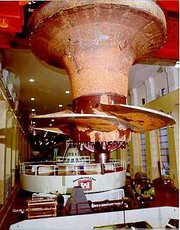Kaplan turbine
|
|
The Kaplan turbine is a propeller-type water turbine that has adjustable blades. It was developed in 1913 by the Austrian professor Viktor Kaplan.
The Kaplan turbine was an evolution of the Francis turbine. Its invention allowed efficient power production in low head applications that was not possible with Francis turbines.
Kaplan turbines are now widely used throughout the world in high-flow, low-head power production.
| Contents |
Development
Victor Kaplan obtained his first patent for an adjustable blade propeller turbine in 1912. But the development of a commercially successful machine would take another decade. Kaplan struggled with cavitation problems, and in 1922 abandoned his research for health reasons.
In 1919 Kaplan installed a demonstration unit at Podebrady, Czechoslovakia. In 1922 Voith (http://www.voith.com) introduced an 1100 HP kaplan turbine for use mainly on rivers. In 1925 an 8 Mw unit went on line at Lilla Edet, Sweden. This marked the commercial success and wide spread acceptance of Kaplan turbines.
Theory of operation
Kaplan_Turbine_schematic.png
The Kaplan turbine is an inward flow reaction turbine, which means that the working fluid changes pressure as it moves through the turbine and gives up its energy. The design combines radial and axial features.
The inlet is a scroll-shaped tube that wraps around the turbine's wicket gate. Water is directed tangentially, through the wicket gate, and spirals on to a propeller shaped runner, causing it to spin.
The outlet is a specially shaped draft tube that helps decelerate the water and recover kinetic energy.
The turbine does not need to be at the lowest point of water flow, as long as the draft tube remains full of water. A higher turbine location, however, increases the suction that is imparted on the turbine blades by the draft tube. The resulting pressure drop may lead to cavitation.
Variable geometry of the wicket gate and turbine blades allow efficient operation for a range of flow conditions. Kaplan turbine efficiencies are typically over 90%, but may be lower in very low head applications.
Current areas of research include CFD driven efficiency improvements and new designs that raise survival rates of fish passing through.
Applications
Kaplan turbines are widely used throughout the world for electrical power production. They cover the lowest head hydro sites and are especially suited for high flow conditions.
Inexpensive micro turbines are manufactured for individual power production with as little as two feet of head.
Large Kaplan turbines are individually designed for each site to operate at the highest possible efficiency, typically over 90%. They are very expensive to design, manufacture and install, but operate for decades.
Variations
Propeller_Turbine.jpg
The Kaplan turbine is the most widely used of the propeller-type turbines, but several other variations exist:
Propeller turbines have non-adjustable propeller vanes. They are used in low cost, small installations. Commercial products exist for producing several hundred watts from only a few feet of head.
Bulb or Tubular turbines (http://www.tic.toshiba.com.au/website/newtic/hyd_tbtu.htm) are designed into the water delivery tube. A large bulb is centered in the water pipe which holds the generator, wicket gate and runner. Tubular turbines are a fully axial design, whereas Kaplan turbines have a radial wicket gate.
Pit turbines are bulb turbines with a gear box. This allows for a smaller generator and bulb.
Straflo turbines are axial turbines with the generator outside of the water channel, connected to the periphery of the runner.
S- turbines eliminate the need for a bulb housing by placing the generator outside of the water channel. This is accomplished with a jog in the water channel and a shaft connecting the runner and generator.
Tyson turbines are a fixed propeller turbine designed to be immersed in a fast flowing river, either permanently anchored in the river bed, or attached to a boat or barge.
See also
External links
- Toshiba Turbines (http://www.toshiba.co.jp/f-ene/hydro/english/products/equipment/index01_2.htm)
- Micro Propeller Turbine (http://www.waterturbine.com/NewFiles/Powerpal%20Lowhead.html)cs:Kaplanova turbína

